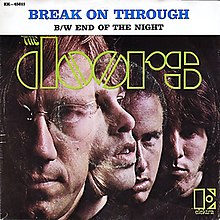Break On Through (To the Other Side)
| "Break On Through (To the Other Side)" | ||||
|---|---|---|---|---|

Cover of the 1967 US single
|
||||
| Single by The Doors | ||||
| from the album The Doors | ||||
| B-side | "End of the Night" | |||
| Released | January 1, 1967 | |||
| Format | 7" | |||
| Recorded | August 1966 | |||
| Genre | Psychedelic rock | |||
| Length | 2:26 | |||
| Label | Elektra | |||
| Writer(s) | The Doors | |||
| Producer(s) | Paul A. Rothchild | |||
| The Doors singles chronology | ||||
|
||||
"Break On Through (To the Other Side)" is a song by The Doors from their debut album, The Doors. It was the first single released by the band and was unsuccessful compared with later hits, reaching only number 126 in the United States. Despite this, it became a concert staple and remains one of the band's signature and most popular songs.
Twenty-four years after its original US release, "Break On Through" became a minor hit in the UK, peaking at number 64 in the singles chart.
The song appears as track one on the band's debut album. Elektra Records edited the line "she gets high," knowing a drug reference would discourage airplay. The original album version and all re-issues until the 1990s have the word "high" deleted, with Morrison singing "she gets" four times before a final wail. Live versions and more recent remastered releases have the full line restored. Regardless, classic rock radio stations, the iTunes release and most compilations continue to use the censored version, as it is the version most familiar to listeners.
The song is in 4/4 time and quite fast-paced.
It begins with a bossa nova drum groove in which a clave pattern is played as a rim click underneath a driving ride cymbal pattern. John Densmore appreciated the new (at the time) bossa nova craze coming from Brazil, so he decided to use it in the song.Robby Krieger has stated that the guitar riff he played was inspired by the one in Paul Butterfield's version of the song "Shake Your Moneymaker" (originally by blues guitarist Elmore James).
Later, a disjointed quirky organ solo is played quite similar to the introduction of Ray Charles' "What'd I Say", which has a few intentional misplaced notes in it. The bassline, similar to a typical bass line used in bossa nova, continues almost unhindered all of the way through the song.
...
Wikipedia
